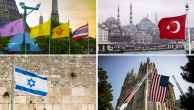Religious “nones” are people who describe themselves as atheist, agnostic or “nothing in particular” when asked about their religious affiliation in our surveys.
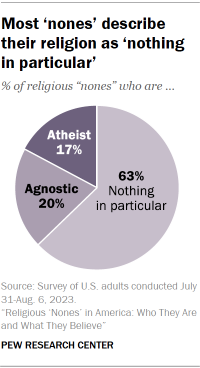
To measure religious affiliation in the United States, we asked: “What is your present religion, if any?” followed by a list of options:
- Protestant (for example, Baptist, Methodist, nondenominational, Lutheran, Presbyterian, Pentecostal, Episcopalian, Church of Christ, Congregational/United Church of Christ, Holiness, Reformed, Church of God, etc.)
- Roman Catholic
- Mormon (Church of Jesus Christ of Latter-day Saints or LDS)
- Orthodox (such as Greek, Russian, or some other Orthodox Church)
- Jewish
- Muslim
- Buddhist
- Hindu
- Atheist
- Agnostic
- Something else (please specify what)
- Nothing in particular
Respondents who choose atheist, agnostic or “nothing in particular” are categorized by Pew Research Center as religiously unaffiliated – a group that the Center and many others have taken to calling “nones.”
Most “nones” describe their religion as “nothing in particular” (63%), while 17% say they are atheist and 20% say they are agnostic.
We use the terms “religiously unaffiliated” and “religious nones” interchangeably. Sometimes we also refer to the “nones” as people who claim “no religion” or people who don’t identify with any religion.
Meanwhile, we use the term “religiously affiliated” for respondents who identify with one of the religions listed above – including a relatively small number who choose “something else” and then write in what it is, as well as those who say they have more than one religion.
Demographics of religious ‘nones’
Age and gender
The population of religious “nones” in the U.S. is younger than the population of Americans who identify with a religion.
Among “nones,” 69% are under the age of 50, while 31% are 50 or older. By comparison, 45% of U.S. adults who identify with a religion are under 50, while 55% are ages 50 or older.
“Nones” overall are roughly split between men (51%) and women (47%). The populations of atheists and agnostics include far more men than women. The same is not true for people whose religion is “nothing in particular.”
(For more information on religious differences between men and women, refer to “The Gender Gap in Religion Around the World.”)
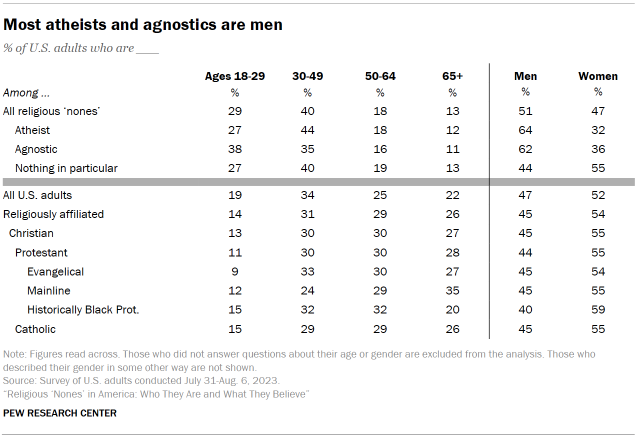
Race and ethnicity
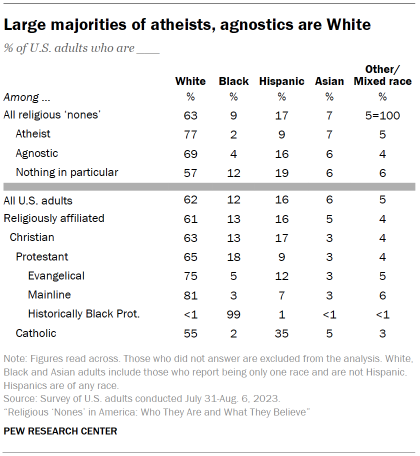
The racial breakdown of U.S. “nones” is broadly similar to the racial breakdown of Americans who identify with a religion.
That said, White adults make up larger shares of U.S. atheists (77%) and agnostics (69%) than of people whose religion is “nothing in particular” (57%).
Just 2% of self-described atheists and 4% of agnostics are Black.
Education

The populations of “nones” and of religiously affiliated adults in the United States have similar levels of education, respectively.
Among “nones,” though, atheists and agnostics have more education than those whose religion is “nothing in particular.”
Atheists and agnostics are also more likely to have a college degree than are Americans who identify with a religion.
Party identification and political ideology of religious ‘nones’
Ideologically, American “nones” are much more likely than religiously affiliated adults to identify as liberal and less likely to identify as conservative.
Majorities of atheists (65%) and agnostics (56%) are ideologically liberal. Among those who say their religion is “nothing in particular,” the largest share identify as moderate (46%).
Overall, 62% of “nones” identify as Democrats or lean toward the Democratic Party. Atheists (78%) and agnostics (71%) are more likely to be Democrats or lean Democratic than are U.S. adults who identify religiously as “nothing in particular” (54%).
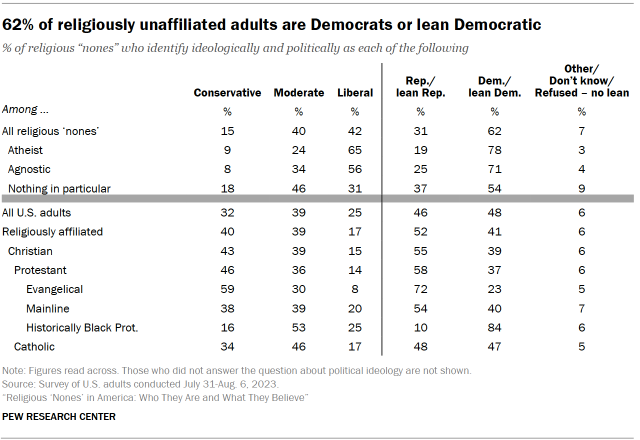
Return to the report’s Overview.
Find answers to other questions:
- Why are ‘nones’ nonreligious? (Chapter 2)
- Are ‘nones’ less involved in civic life than people who identify with a religion? (Chapter 3)
- Are all ‘nones’ nonbelievers? (Chapter 4)
- Are ‘nones’ spiritual instead of religious? (Chapter 5)
- Are ‘nones’ hostile toward religion? (Chapter 6)
- How do ‘nones’ view science? (Chapter 7)
- How do ‘nones’ think about morality? (Chapter 8)
